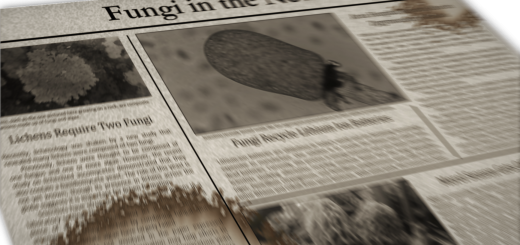#111: Stemonitis spp., Chocolate Tube Slime Molds or Tree Hair
“Hair Growing on Wood – Believe it or Not” proclaimed one of the exhibits at the Ripley’s Believe it or Not pavilion during the 1933 World’s Fair in Chicago. The curious organism on display was Stemonitis fusca, which belongs to a group of organisms commonly known as “Chocolate Tube Slime Molds” or “Pipe Cleaner Slime Molds.” However, thanks to its moment of fame 82 years ago, “Tree Hair” is also an acceptable common name for these species.
The mature fruiting bodies of Stemonitis species feature a thin, black filament that bears aloft a thicker (1-1.5mm), chocolate-brown, spore-bearing cylinder. Each sporangium is usually no more than 2cm (<1in) tall, so these structures are really quite small. Luckily, each slime mold usually produces clusters of sporangia, making them easier to spot. Half to two thirds of the sporangium’s height is taken up by the larger, spore-bearing cylinder. Stemonitis species are difficult to tell apart without using a microscope, so most people are content with identifying these organisms to genus only.
“Chocolate Tube,” “Pipe Cleaner,” and “Tree Hair” are all apt descriptors for this genus of slime molds. My favorite name is Tree Hair, since it often does look like the log is trying to grow some hair. Additionally, you can find Tree Hair in a variety of different “dos,” which relates to how old the structures are. Younger sporangia are closely packed together, as if trying to go for a spiked hairdo. Older sporangia are looser and more haphazard, as if tousled. “Chocolate Tube” is a wonderful characterization of the upper, spore-bearing surface’s color and shape. “Pipe Cleaner” calls to mind a thin filament supporting a larger cylinder, which describes the overall structure of the sporangium pretty well.
Stemonitis belongs to the plasmodial slime molds and is not a fungus. Plasmodial slime molds spend most of their lives as enormous, single-celled organisms. The largest of these slime molds can get up to a couple meters across but are still composed of only one cell! In the case of Stemonitis, the cells are usually only a few centimeters across. Each cell has thousands of nuclei but no cell walls or other divisions to separate the cytoplasm into compartments. The nuclei in the slime mold are diploid, meaning they have two complete sets of chromosomes. Plasmodial slime molds produce haploid spores, which germinate and then crawl and/or swim around until they find an acceptable, germinated spore with which to mate. The two germinated spores fuse to produce a diploid cell, thus starting the life cycle over again.
For most of its life, a Stemonitis slime mold crawls through forest litter using amoeboid motion and eats (by phagocytosis, where the cell surrounds and engulfs its food) organic particles and microscopic decomposers like bacteria and fungi. When resources run out or conditions become unfavorable, the slime mold crawls to the surface of its substrate to produce sexual spores. The fruiting bodies of Stemonitis species start out as small, yellow bumps that look like a cluster of insect eggs. These bumps gradually elongate and turn light brown. Next, the sporangia acquire their pipe cleaner shape and turn black. As they dry out, the powdery, brown spores are released and give the surface of each “tube” its characteristic, chocolate-brown color. The spores are dispersed by the wind, and often turn nearby surfaces brown. See the bucksfungusgroup.org.uk page listed below* for good pictures of the fruiting process.
See Further:
* http://www.bucksfungusgroup.org.uk/articles.html#slimemould
http://www.messiah.edu/oakes/fungi_on_wood/club%20and%20coral/species%20pages/Stemonitis.htm
http://website.nbm-mnb.ca/mycologywebpages/NaturalHistoryOfFungi/SlimeMoulds.html
http://www.geograph.org.uk/photo/1046280








![#011: Characteristics of Kingdom Fungi [Archived]](https://www.fungusfactfriday.com/wp-content/themes/hueman/assets/front/img/thumb-small-empty.png)
